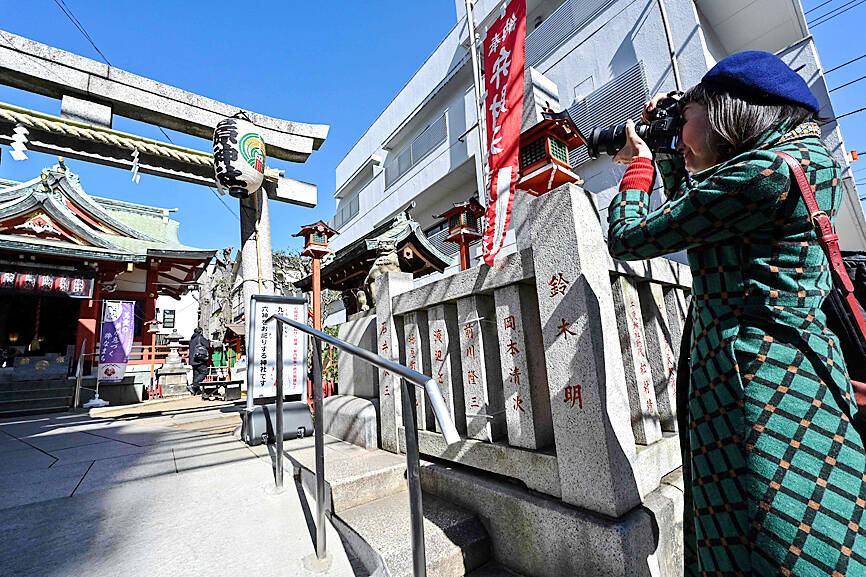It was late morning and steam was rising from water tanks atop the colorful, but opaque-windowed, “soapland” sex parlors in a historic Tokyo red-light district.
Walking through the narrow streets, camera in hand, was Beniko — a former sex worker who is trying to capture the spirit of the area once known as Yoshiwara through photography.
“People often talk about this neighborhood having a ‘bad history,’” said Beniko, who goes by her nickname. “But the truth is that through the years people have lived here, made a life here, sometimes struggled to survive. I want to share that reality.”

Photo: AFP
In its mid-17th to 19th century heyday, Yoshiwara was home to high-class courtesans who sold a world of luxurious closed-door entertainment and fantasy.
The sole entrance to the lively walled pleasure quarters was a huge golden gateway topped with a figurine of Benten, the goddess of music, art, wealth and femininity.
Today the same point is marked by two plain pillars, and the brothels of the area in eastern Tokyo are often run under the guise of bathhouses.

Photo: AFP
Beniko, 52, spent a decade working in one of the so-called soaplands after a difficult childhood during which she was bullied at school.
While studying art in the capital, she began working part-time at a small city-center establishment selling sexual services, then at age 22, she moved to Senzoku Yon-chome, the modern name for the old Yoshiwara area.
A former client had “made Yoshiwara out to be hell on earth. He said: ‘If you go there, your life will be over,’” she said. “But I felt like I belonged nowhere, so I decided to take myself there.”
To regulate the sex industry, the Yoshiwara red-light district was originally built in a different part of Tokyo in 1618, with entry tightly controlled to stop the women from escaping.
However, after being razed in a fire 40 years later, it was moved to east Tokyo, close to current-day tourist hot spot Asakusa.
Yoshiwara prospered in that location until the end of Japan’s Edo period in 1868, but it went into decline as the country modernized and when sex work was outlawed in 1958.
Beniko’s photographs, taken in Tokyo, but also in other Japanese red-light districts, focus mainly on the buildings and rooms used that are usually hidden from view.
After the success of her first photography book, Beniko financed another through online donations.
She crowd-funded ¥8.2 million (US$55,165), beating her ¥1 million goal many times over.
“I can’t make up for lost time, but I want to document the sex industry as part of history,” said Beniko, who also runs guided tours of the area.
It is a purpose shared by Go Watanabe, who runs the Senzoku Yon-chome bookshop Kastori, which specializes in the stories of former and active red-light districts in Japan.
“Of course, there are many complicated issues here, but does that mean we should simply hide or erase a town with such a complex history? Personally, I don’t think so,” he said.
By her early 30s, Beniko felt she had no future and was suffering intense physical pain.
“Some days I would see 10 clients,” she said. “I was a shell, both physically and mentally.”
She decided to focus on raising her son and found a regular part-time job, then began to teach herself photography techniques, throwing herself into the art form.
Speaking openly about sex is still somewhat taboo in Japan, but Beniko has always shown her face, including on her YouTube channel — making her the target of vicious online attacks.
“I’ve received many comments like: ‘A child brought up by a woman like you, a former prostitute, will never turn out OK,’” she said.
However, “if I didn’t show my face and speak about it openly, it wouldn’t have the same impact — or people wouldn’t truly understand,” she added.
Unlike the bright, brash Kabukicho red-light district in the central Shinjuku area of Tokyo, until recently tourists were a rare sight in Senzoku Yon-chome.
In the past few years, outside interest in the area’s history has been growing, helped by its portrayal in pop culture such as the global hit anime movie Demon Slayer.
Yoshiwara has also featured as a backdrop in a period drama shown this year on public broadcaster NHK, piquing the interest of some Japanese people curious about lesser-known historic areas of their capital.
As Japanese society changes and “external constraints” over customs and lifestyles dissipate, “some people feel a sense of unease,” Watanabe said. “That’s why many of them are looking into history, as a way to understand their own sexuality and identity.”

Taiwan Semiconductor Manufacturing Co (TSMC, 台積電) last week recorded an increase in the number of shareholders to the highest in almost eight months, despite its share price falling 3.38 percent from the previous week, Taiwan Stock Exchange data released on Saturday showed. As of Friday, TSMC had 1.88 million shareholders, the most since the week of April 25 and an increase of 31,870 from the previous week, the data showed. The number of shareholders jumped despite a drop of NT$50 (US$1.59), or 3.38 percent, in TSMC’s share price from a week earlier to NT$1,430, as investors took profits from their earlier gains

In a high-security Shenzhen laboratory, Chinese scientists have built what Washington has spent years trying to prevent: a prototype of a machine capable of producing the cutting-edge semiconductor chips that power artificial intelligence (AI), smartphones and weapons central to Western military dominance, Reuters has learned. Completed early this year and undergoing testing, the prototype fills nearly an entire factory floor. It was built by a team of former engineers from Dutch semiconductor giant ASML who reverse-engineered the company’s extreme ultraviolet lithography (EUV) machines, according to two people with knowledge of the project. EUV machines sit at the heart of a technological Cold

TAIWAN VALUE CHAIN: Foxtron is to fully own Luxgen following the transaction and it plans to launch a new electric model, the Foxtron Bria, in Taiwan next year Yulon Motor Co (裕隆汽車) yesterday said that its board of directors approved the disposal of its electric vehicle (EV) unit, Luxgen Motor Co (納智捷汽車), to Foxtron Vehicle Technologies Co (鴻華先進) for NT$787.6 million (US$24.98 million). Foxtron, a half-half joint venture between Yulon affiliate Hua-Chuang Automobile Information Technical Center Co (華創車電) and Hon Hai Precision Industry Co (鴻海精密), expects to wrap up the deal in the first quarter of next year. Foxtron would fully own Luxgen following the transaction, including five car distributing companies, outlets and all employees. The deal is subject to the approval of the Fair Trade Commission, Foxtron said. “Foxtron will be

INFLATION CONSIDERATION: The BOJ governor said that it would ‘keep making appropriate decisions’ and would adjust depending on the economy and prices The Bank of Japan (BOJ) yesterday raised its benchmark interest rate to the highest in 30 years and said more increases are in the pipeline if conditions allow, in a sign of growing conviction that it can attain the stable inflation target it has pursued for more than a decade. Bank of Japan Governor Kazuo Ueda’s policy board increased the rate by 0.2 percentage points to 0.75 percent, in a unanimous decision, the bank said in a statement. The central bank cited the rising likelihood of its economic outlook being realized. The rate change was expected by all 50 economists surveyed by Bloomberg. The